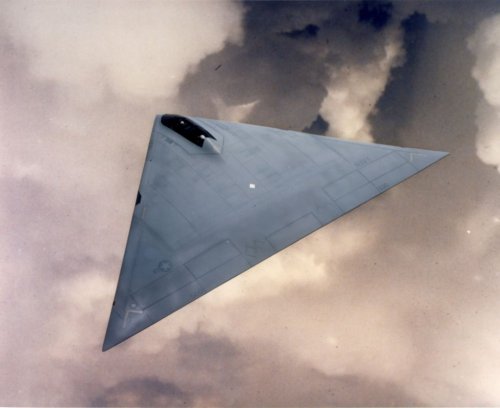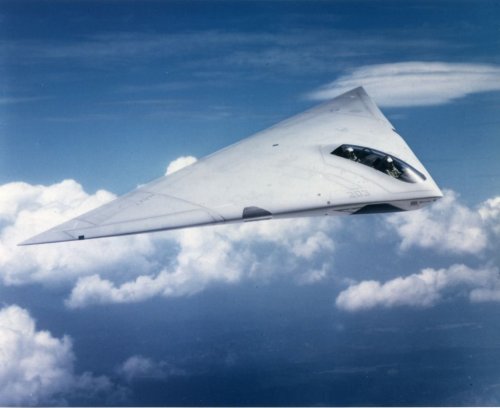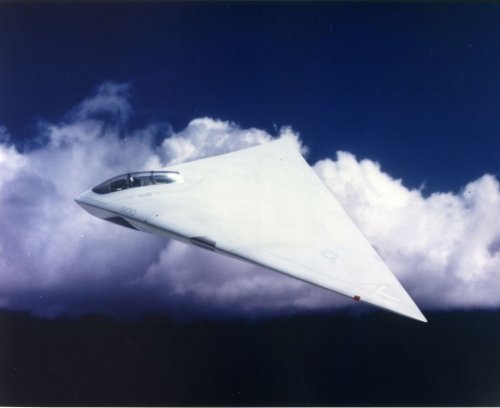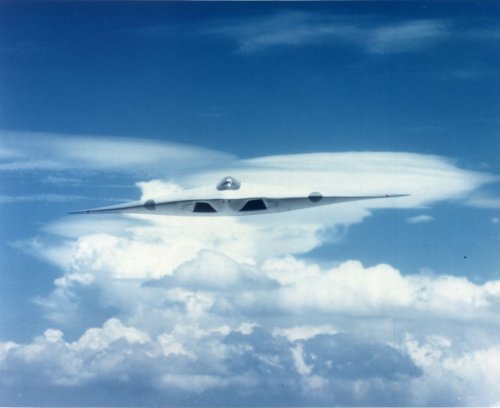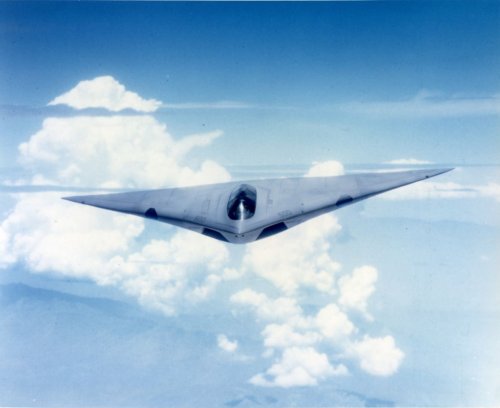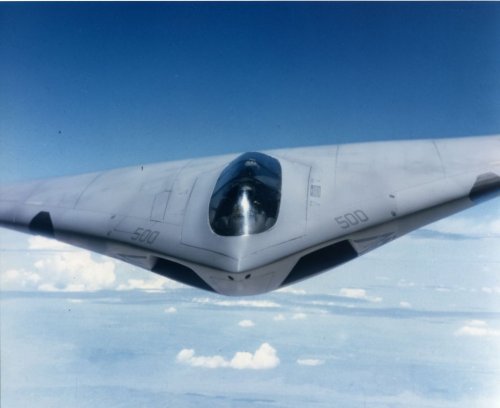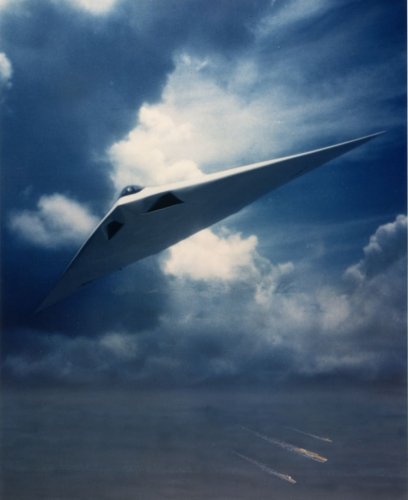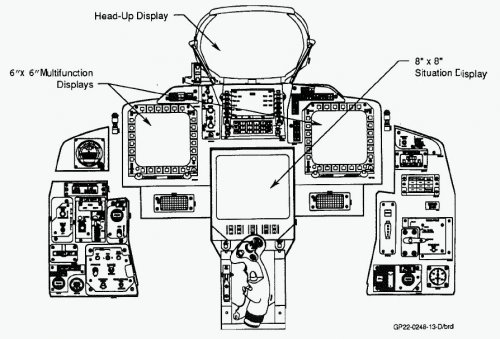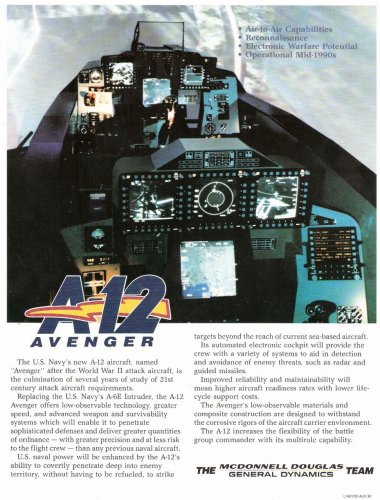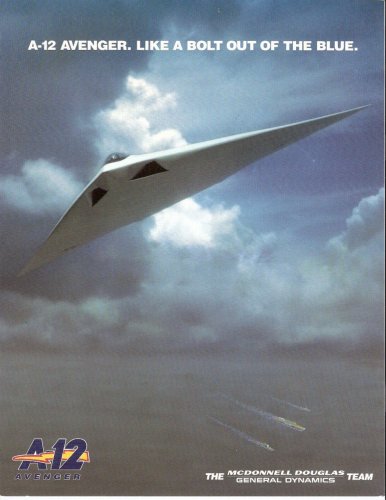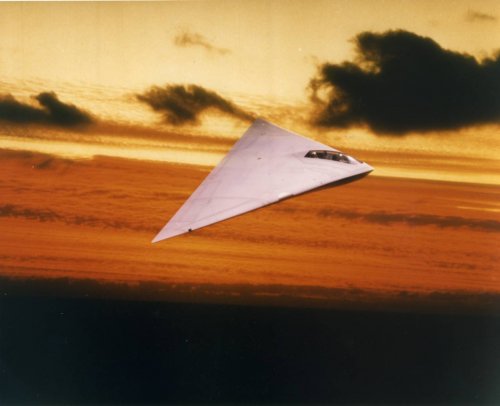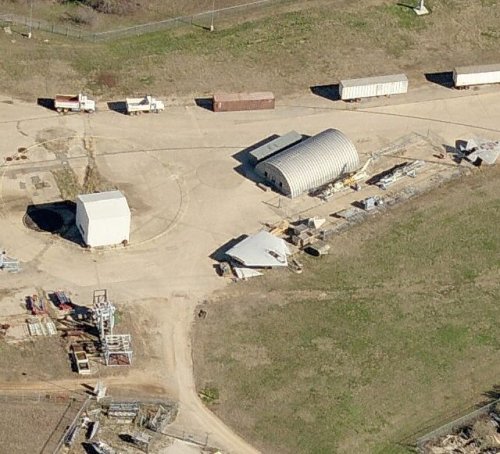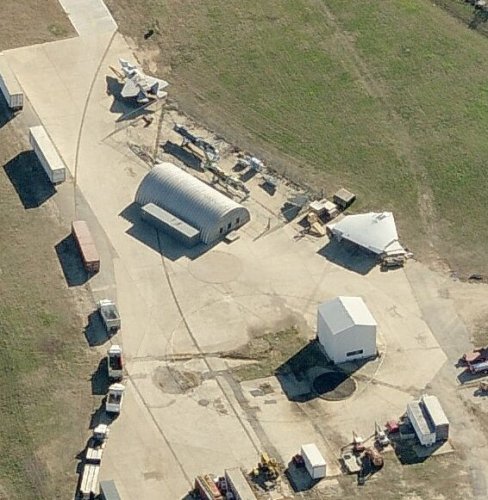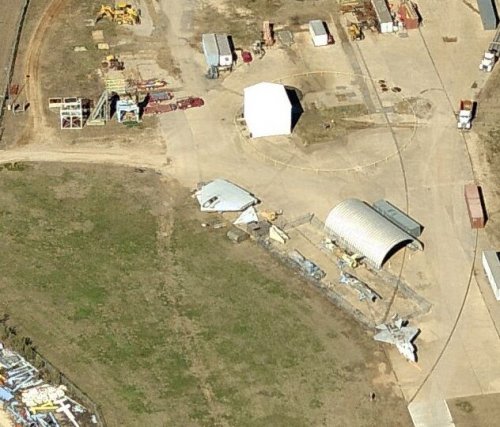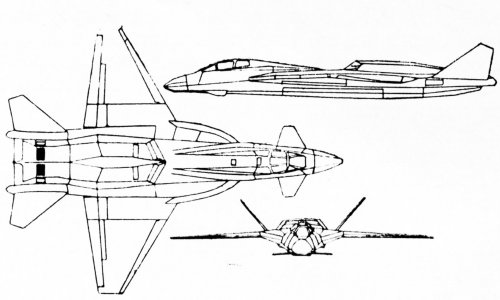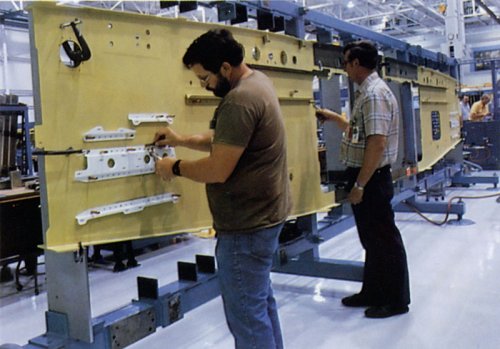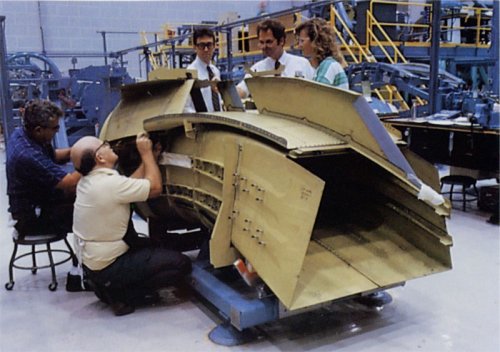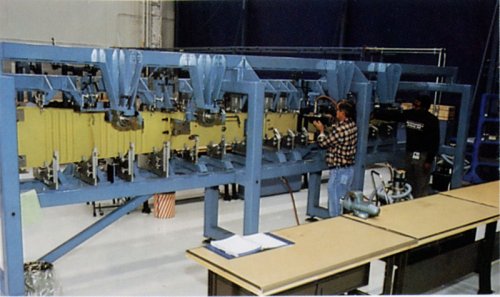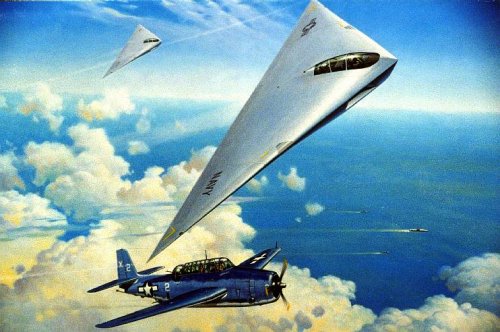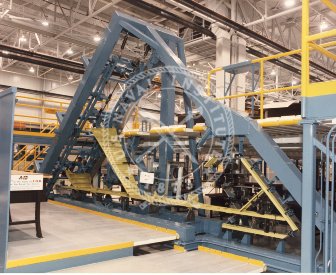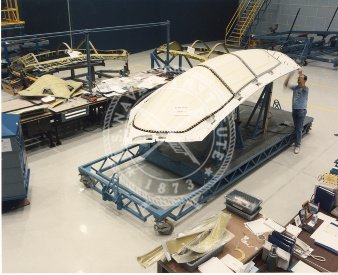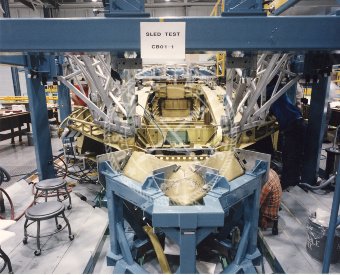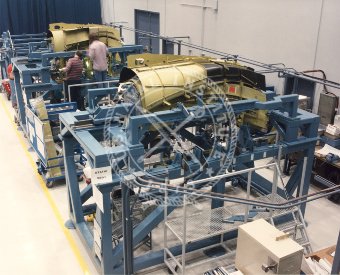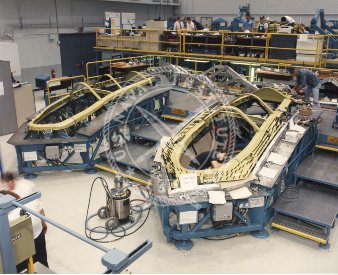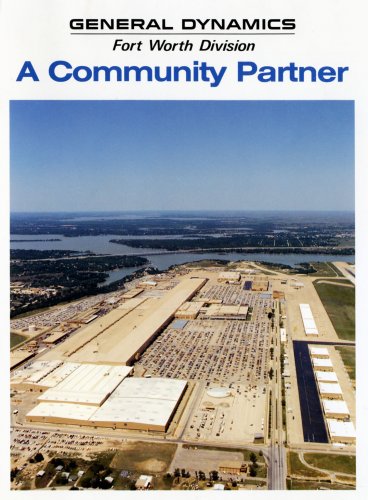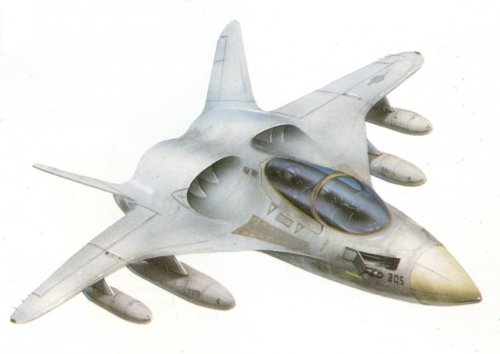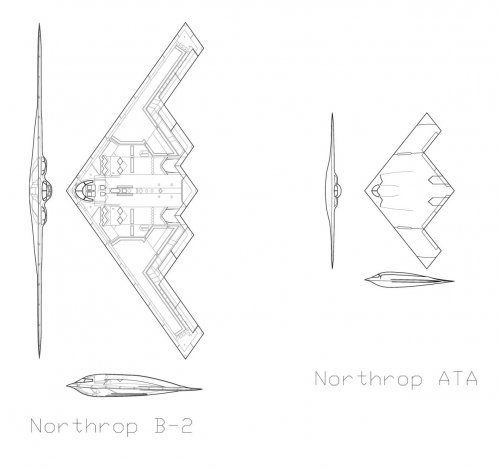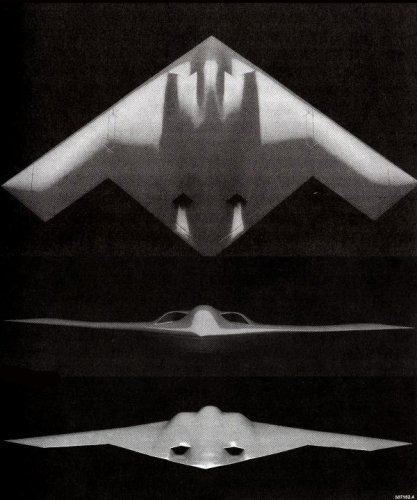You are using an out of date browser. It may not display this or other websites correctly.
You should upgrade or use an alternative browser.
You should upgrade or use an alternative browser.
US NAVY ATA (Advanced Tactical Aircraft) program: A-12 Avenger II & its rivals
- Thread starter overscan (PaulMM)
- Start date
- Joined
- 6 August 2007
- Messages
- 3,843
- Reaction score
- 5,691
flateric said:I'm very sceptic about possibility to get them because many things were and stay classified of Flying Dorito. News that museum stuff ever had them is a breakthrough for me - you should have been using this rare chance if you still have his contacts.
Much of the A-12 program found its way into other things. The radar used on the Global Hawk, for example, has it's roots in the A-12's SAR. A lot of the interesting and expensive things created during the A-12 program later flew on other aircraft in Nevada and elsewhere.
- Joined
- 1 April 2006
- Messages
- 11,343
- Reaction score
- 10,016
These are official A-12 renderings, that obviously were made using 1/12 highly detailed factory model pictures as a basis.
Now it's quite rare stuff to find anywhere. Enjoy!
Now it's quite rare stuff to find anywhere. Enjoy!
Attachments
- Joined
- 1 April 2006
- Messages
- 11,343
- Reaction score
- 10,016
archipeppe
ACCESS: Top Secret
- Joined
- 18 October 2007
- Messages
- 2,428
- Reaction score
- 3,121
Great flateric!
I've always wondering about the look of A12's cockpit...
I've always wondering about the look of A12's cockpit...
- Joined
- 1 April 2006
- Messages
- 11,343
- Reaction score
- 10,016
archipeppe said:Great flateric!
I've always wondering about the look of A12's cockpit...
http://www.habu2.net/a12/a_ckpit.htm
elmayerle said:I've been told that the A-12 mockup is now in the "storage area" at the north end of the plant here in Fort Worth.
It was certainly there when the pics for MS Virtual Earth were taken
Attachments
- Joined
- 26 May 2006
- Messages
- 34,711
- Reaction score
- 15,544
Deino said:Regarding the other ATA contenders I only have these two pictures ... the first from the FLUG Revue (issue ??) saying it shows a Boeing/Rockwell design and another one without any source !
PS ... + a wonderful build Model in 1/48 scale ....
Deino
From Flightglobal;
http://www.flightglobal.com/PDFArchive/View/1986/1986%20-%202890.html?search=aircraft%201986
- Joined
- 17 October 2006
- Messages
- 2,393
- Reaction score
- 1,191
Jeez, what were they smoking?
- Joined
- 3 June 2006
- Messages
- 3,086
- Reaction score
- 3,909
...and the F/A-37 "Talon".MihoshiK said:Almost looks like something from "Space, Above and Beyond"...
Great find, flateric!
Would love to see profiles or CGI's done at WiF and by Planepictures.
- Joined
- 17 October 2006
- Messages
- 2,393
- Reaction score
- 1,191
I have information that suggests that the "ATA" origins are highly unofficial. Although I'm sure its creator would be flattered to see it in a TsAGI handbook. ;D
- Joined
- 1 April 2006
- Messages
- 11,343
- Reaction score
- 10,016
- Joined
- 17 October 2006
- Messages
- 2,393
- Reaction score
- 1,191
Looks like totally efficient manufacturing going on in that middle pic...
- Joined
- 1 April 2006
- Messages
- 11,343
- Reaction score
- 10,016
These would be nice illustrations for the mid section of Stevenson's The '$5 Billion Misunderstanding', yeah....
"We should stay overnight...Cheney will come tomorrow at 10 A.M. and we still need to understand where's right wing console"
"We should stay overnight...Cheney will come tomorrow at 10 A.M. and we still need to understand where's right wing console"
- Joined
- 1 April 2006
- Messages
- 11,343
- Reaction score
- 10,016
pometablava said:Can anybody add more information about that three GD projects please?
http://www.codeonemagazine.com/archives/1998/articles/apr_98/apra_98.html
http://www.codeonemagazine.com/archives/1998/articles/oct_98/oct2a_98.html
- Joined
- 1 April 2006
- Messages
- 11,343
- Reaction score
- 10,016
From the (never built) Forth Worth Aviation Heritage Museum site
"The painting of the A-12 was one of the last done by the late General Dynamics artist, Bob Cunningham. The TBM Avenger in the painting was the one flown by President George Bush, who went to Fort Worth and dedicated the A-12 when it was still classified. The A-12 was to have been the Avenger II."
"The painting of the A-12 was one of the last done by the late General Dynamics artist, Bob Cunningham. The TBM Avenger in the painting was the one flown by President George Bush, who went to Fort Worth and dedicated the A-12 when it was still classified. The A-12 was to have been the Avenger II."
Attachments
- Joined
- 1 April 2006
- Messages
- 11,343
- Reaction score
- 10,016
US Naval Institute sells some interesting A-12 manufacturing photos...'Digital Download $29.97 each'
In this case cats' feeding would not be an excuse, I suppose...
As Overscan have suggested, 'Navy is trying to recoup A-12 costs'
In this case cats' feeding would not be an excuse, I suppose...
As Overscan have suggested, 'Navy is trying to recoup A-12 costs'
Attachments
Some guy had some A-12 structural drawings on the web years ago. That would be awesome to have since I'd love to make a cutaway of an A-12. There is so much info on it yet I haven't seen any illustrations of it.
- Joined
- 1 April 2006
- Messages
- 11,343
- Reaction score
- 10,016
elmayerle said:Well, it's not quite that big, though the main assembly area is a mile long. The "dump" as at the extreme north end of the facility, up against the edge of Lake Worth.
Attachments
- Joined
- 2 August 2006
- Messages
- 3,251
- Reaction score
- 1,511
Some guy had some A-12 structural drawings on the web years ago. That would be awesome to have since I'd love to make a cutaway of an A-12. There is so much info on it yet I haven't seen any illustrations of it.
Do you mean these?
Pyrrhic victory
This is going to hurt
- Joined
- 31 January 2008
- Messages
- 75
- Reaction score
- 78
Here's a December 1995 email from the Skunk Works Digest concerning the A-12 authored by Art Hanley. Some interesting bits about the teaming of the two competitors and the stringent VLO requirements.
http://www.netwrx1.com/skunk-works/v05.n570
The Advanced Tactical Aircraft program was, basically put, the
future of Naval Aviation. It was to be a first-day survivable strike
aircraft that could operate in all weather, day or night, and possess
good self defense capability against aerial threats, although not be
designed for offensive counter-air operations. It would replace the
A-6 and have a greater radius of action. Very heavy emphasis was
placed on stealth (in the opinion of many, too heavy an emphasis) and
all weapons were to be carried internally. It would have been the
stealthiest aircraft ever. To give an idea of how heavily stealth
characteristics were pushed, one of the requirements that has been
disclosed would have required the plane to open the weapons bay
doors, eject the weapon(s) and close the doors in 1/2 second. This
is doable, but it has many consequences in design and drives the cost
up. This could be a real problem since this was to be one of those
consistently disastrous fixed price development contracts.
The Department of the Navy insisted that companies team for the
competition. Although never Officially confirmed, it was believed
by some that Department of Navy not only required teams, but directed
who was to team with who. This is believable when you saw Grumman
teamed with Northrop and GD teamed with Macair. In those days, a
voluntary teaming probably would have resulted in a MDD-Northrop
team, as they had done in the past on the F/A-18, as well as on the
YF-23. Tthis made for awkward meetings at the plants when the two
companies were pals on the ATF but foes on the ATA. This also
prevented cross fertilization of technologies within the companies.
For example, the MDD people working on the ATF team were able to
share the benefit of Northrop's experience in developing stealth
technology for the B-2 (one of the reasons that the YF-23 was the
stealthier of the two ATF competitors), while the MDD people working
on the ATA team were forbidden to be told anything about it. I have
been told that at that time the Grumman-Northrop pairing was not a
happy one either.
This posed a problem. The Grumman-Northrop team had a leader with
55 years of building carrier aircraft, and had built the long range
attack aircraft the ATA was to replace, and a team member with an
enviable reputation for weight control and had built the world's
stealthiest aircraft. Both team members had large scale composite
structure experience. The GD-MDD team was lead by a company with no
carrier air experience and had weight problems on previous aircraft.
The other team member had been building naval aircraft for some time,
but the portion of that company that had built large attack aircraft
for the Navy, Douglas, had not designed one of them since the early
1950s. Needless to say, this team was at somewhat of a disadvantage.
The design competition went forward. It is known that there were
discussions with the Grumman-Northrop (and Vought) team (whose
design has been said to resemble a smaller, tandem seat B-2) to
reduce their bid down to what the Government wanted the plane to
cost. Grumman, having gone through this before on the original F-14
contract, along with Northrop basically said, 'Look, we Know how to
build this plane and you can't do it for that amount of money'.
According to published reports the Government said it was this or
else and the team responded with what was a polite form of, 'O.K.,
See Ya!', and walked away. This only left one team, and they got the
contract.
The A-12 had a number of serious problems in development. One of
the most serious was that the team had to essentially reinvent
stealth technology. The team expected that they would be provided
technological data from previous stealth programs, notably the F-117
and B-2, to which Northrop and Lockheed said, 'Say, What? That's our
proprietary technology and processes and you want us to give it to
Who? For a plane we aren't even building'? This drove up costs and
produced delays while GD and MDD labored to reinvent the wheel. Of
course, since this was a fixed price development contract, there was
no guarantee they'd get paid extra for this. Weight problems also
developed, partly but not solely because the RAM being developed
wasn't as light as estimates. Later reports indicate that MDD, who
had carrier experience, tried to raise bigger warning flags about
weight control but that the team leaders didn't realize how really
critical this was on a carrier plane. DoD also thought that
management improvements could solve all the problems. It is also
known that some of the problems were in fact concealed from DoD. The
final straw came when soon after a major management review where DoD
seemed assured that that had good cost and schedule figures and so
briefed Congress, it surfaced that the plane would experience another
delay and an additional $1 billion would be needed for R&D to meet
spec. This embarrassment was coupled with the fact that rigid
fixed-price development contracts have little or no adaptability
(something we have to relearn ever 20 years or so) which means a
go/no go decision had to be made. The Air Force said it was fully
supportive of this magnificent joint development, was unequivocally
committed to the program (the A-12 was to be the F-111 replacement),
and could they please have more F-15Es instead? All this led
Secretary of Defense Cheney to cancel the program when the first
prototype was about 80% complete.
This devastated Naval Air, and also had an adverse affect on the RAF
which fully planned to buy the A-12 as their principal strike
aircraft. While a relief, there were a number who thought the program
should have been restructured not cancelled. Their argument was that
the plane had serious problems, but they were fixable and doing that
would cost far less than starting something else, plus you'd actually
end up with an airplane instead of more studies. This prediction has
unfortunately proved correct since the Navy is now going to spend
much more in R&D to get a strike aircraft much less capable than the
A-12.
The replacement program was the AX (which eventually became the
A/FX). There was more user input to the requiremnts for this plane
which actually would have been a more useful plane than the A-12.
Not as stealthy (but still a stealth aircraft), it would have had
better provision for more flexible payloads, would have had somewhat
less range (although still more than A-6's), but would have greater
counter-air capability. It would have had offensive air-to-air
abilities and would be more maneuverable and faster. A bunch of
different teams formed for that one with some companies competing
with themselves by being on different teams with different partners.
The record, I think, went to Lockheed which was on at least four
teams with different partners ( I can list all the teams if anyone's
interested, but it's complicated enough to require a program). A/FX
sort of moved along for a while, its IOC was moved back partly to
make room for the F/A-18E/F. The Air Force said it was fully
supportive of this magnificent joint development, was unequivocally
committed to the program (the A/FX was now to be the F-111
replacement), and could they please have more B-2s instead? A/FX
just sorta went away and along came the first of the many
incarnations of JAST. The JAST (JSF) aircraft, by the way is not
planned to be able meet the A/FX requirements.
Meanwhile, back in court, the A-12 team and the Government were
suing each other. The Government said that the program was
terminated for non-performance and that certain problems were
concealed from it. It says it is entitled to get back the money it
spent on the program. The A-12 team said that the program was
terminated at the convenience of the Government. Their main
arguments are that they made it clear that their schedules and costs
were based on the Government supplying them with stealth and
composite construction technology data, which didn't happen, and that
while they were indeed overweight on the prototype, the contract
specified that they didn't have to meet the weight target until the
32nd aircraft and they claim they would have made it by then. If
this was a convenience of the Government termination, then the
contractors are entitled to reimbursement for their costs and
possibly penalties as well. So Far, the courts have tended to rule
in favor of the contractors, but everybody is appealing everything
(you're not surprised, are you?).
http://www.netwrx1.com/skunk-works/v05.n570
- Joined
- 3 October 2007
- Messages
- 1,960
- Reaction score
- 1,191
Pyrrhic victory said:Here's a December 1995 email from the Skunk Works Digest concerning the A-12 authored by Art Hanley. Some interesting bits about the teaming of the two competitors and the stringent VLO requirements.
<snip>
The A-12 had a number of serious problems in development. One of
the most serious was that the team had to essentially reinvent
stealth technology. The team expected that they would be provided
technological data from previous stealth programs, notably the F-117
and B-2, to which Northrop and Lockheed said, 'Say, What? That's our
proprietary technology and processes and you want us to give it to
Who? For a plane we aren't even building'? This drove up costs and
produced delays while GD and MDD labored to reinvent the wheel. Of
course, since this was a fixed price development contract, there was
no guarantee they'd get paid extra for this.
<snip>
Meanwhile, back in court, the A-12 team and the Government were
suing each other. The Government said that the program was
terminated for non-performance and that certain problems were
concealed from it. It says it is entitled to get back the money it
spent on the program. The A-12 team said that the program was
terminated at the convenience of the Government. Their main
arguments are that they made it clear that their schedules and costs
were based on the Government supplying them with stealth and
composite construction technology data, which didn't happen, and that
while they were indeed overweight on the prototype, the contract
specified that they didn't have to meet the weight target until the
32nd aircraft and they claim they would have made it by then. If
this was a convenience of the Government termination, then the
contractors are entitled to reimbursement for their costs and
possibly penalties as well. So Far, the courts have tended to rule
in favor of the contractors, but everybody is appealing everything
(you're not surprised, are you?).
http://www.netwrx1.com/skunk-works/v05.n570
In those court cases things have come out that were not known in 1995. For one thing, it turns out it wasn't Northrop and Lockheed' claim of proprietary information that prevented the A-12 team from getting information on stealth technology. It turned out that USAF controlled all access to stealth technology at the time. Now it was known that USAF didn't like the idea of having to buy a Navy plane instead of one of its own, and this may just be coincidental, but it seems that whenever members of the A-12 team needed access to that body of knowledge, it just turned out that they didn't have the acceptable clearances to see that and it wasn't sure when they could get that. Apparently it reached the point that GD-MDD decided they would just have to reinvent everything rather than to keep marching in place. There is some credibility to this because if you think about it, if the Government funded the development of the F-117 and B-2, then the Government, not Lockheed or Northrop owned those technologies and processes, so they themselves data couldn't withhold the Government owned data from another contractor working on a Government program, as long as the recipients had the proper clearances.
Even if they had received the data, the plane still would have been over budget and probably wouldn't have met its promises, but we'll never know. Too bad we didn't get the A/FX, a much better concept. .
- Joined
- 17 October 2006
- Messages
- 2,393
- Reaction score
- 1,191
Couple of points:
The A-12 wasn't really the "stealthiest aircraft ever". The concept was to use a combination of stealth, situational awareness (a breakthrough ESM system) and self-defense (AMRAAMs and HARMs) to get through the defenses.
The lack of a clear lead was definitely an issue. I don't recall a successful two-company program where the roles were as ill defined as they were in this case. Also, my impression is that neither GD nor McDD had a mature in-house LO capability when they started; a whole bunch of LO manufacturing work was to be farmed out to Rockwell in Tulsa (went back to the Hound Dog).
How much would access have helped? It's actually a serious question. The coating and edge technologies used on the F-117 were far too heavy and maintenance-intensive to work for ATA. Ditto, in almost every case, the B-2. And the A-12 was running years ahead of the ATF program, which was never even due to start FSD until 1991, by which time FSD A-12s should have been flying.
The A-12 wasn't really the "stealthiest aircraft ever". The concept was to use a combination of stealth, situational awareness (a breakthrough ESM system) and self-defense (AMRAAMs and HARMs) to get through the defenses.
The lack of a clear lead was definitely an issue. I don't recall a successful two-company program where the roles were as ill defined as they were in this case. Also, my impression is that neither GD nor McDD had a mature in-house LO capability when they started; a whole bunch of LO manufacturing work was to be farmed out to Rockwell in Tulsa (went back to the Hound Dog).
How much would access have helped? It's actually a serious question. The coating and edge technologies used on the F-117 were far too heavy and maintenance-intensive to work for ATA. Ditto, in almost every case, the B-2. And the A-12 was running years ahead of the ATF program, which was never even due to start FSD until 1991, by which time FSD A-12s should have been flying.
But it should be noted that the schedule for ATA was highly ambitious (and unrealistic.) There's a table in the Stephenson book comparing the amount of time between contract award and first flight for various combat aircraft, which lays out the case that the Navy's expectation of a 1991 first flight was totally unrealistic.
I remember seeing the following artwork in the early 1990s when the configuration of the A-12 Avenger II was still secret. I don't remember the name of the book or its author in which this artwork appeared. Does anyone have a better scan of this artwork?
Matej
Multiuniversal creator
Yess, but only in a first edition. Second edition has a small tiny pic on the page 86 with the description generally saying... how we imagined the ATA. But probably its better to scan, because in the first edition it is very big image printed on the both pages.
Merv_P
ACCESS: Confidential
- Joined
- 29 July 2006
- Messages
- 115
- Reaction score
- 17
Matej said:Yess, but only in a first edition. Second edition has a small tiny pic on the page 86 with the description generally saying... how we imagined the ATA. But probably its better to scan, because in the first edition it is very big image printed on the both pages.
You're right; I've dug out my copy of the first edition. Fortunately, though, the image Triton wants is on a single page; the double-page spread is of the aircraft in a different colour scheme. I've attached a scan.
Attachments
Thank you Merv_P. B) I don't recall the other image of the design in a different color scheme. Did this speculative design only appear in Stealth Warplanes by Doug Richardson, or were there other publications/sources that speculated that this was the shape of the U.S. Navy Advanced Tactical Aircraft (ATA)?
Is James P. Stevenson's "The $5 Billion Misunderstanding: The Collapse of the Navy’s A-12 Stealth Bomber Program" the only book to comprehensively deal with the A-12 program?
Regards,
Greg
Regards,
Greg
Pyrrhic victory
This is going to hurt
- Joined
- 31 January 2008
- Messages
- 75
- Reaction score
- 78
[
Inside the Ironworks: How Grumman's Glory Days Faded has a chapter (mostly) devoted to the failed Northrop-Grumman ATA bid. Nothing really technical, just a couple of tid bits about the inlet and weapons bay as well as how the contractor pairings came about.
http://tinyurl.com/cz68sd`(link to google books preview)
GTX said:Is James P. Stevenson's "The $5 Billion Misunderstanding: The Collapse of the Navy’s A-12 Stealth Bomber Program" the only book to comprehensively deal with the A-12 program?
Regards,
Greg
Inside the Ironworks: How Grumman's Glory Days Faded has a chapter (mostly) devoted to the failed Northrop-Grumman ATA bid. Nothing really technical, just a couple of tid bits about the inlet and weapons bay as well as how the contractor pairings came about.
http://tinyurl.com/cz68sd`(link to google books preview)
B-3 ish 

Regards,
Greg

Regards,
Greg
- Joined
- 18 March 2008
- Messages
- 3,529
- Reaction score
- 949
Similar threads
-
Advanced Tactical Support Aircraft (ATSA) US Navy
- Started by dauby09
- Replies: 22
-
Northrop Grumman Supersonic Tailless Air Vehicle (STAV) concept
- Started by flateric
- Replies: 17
-
Convair / General Dynamics Advanced Tactical Fighter (1965)
- Started by overscan (PaulMM)
- Replies: 15
-
VSX / TS-160: Alternatives to the S-3 Viking
- Started by Pioneer
- Replies: 95
-
ADF to LWF: Evolution of the General Dynamics F-16
- Started by overscan (PaulMM)
- Replies: 136

